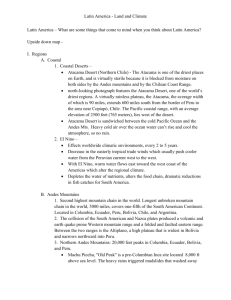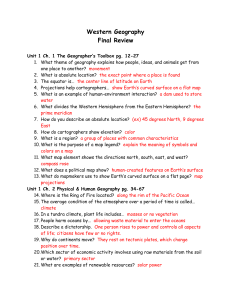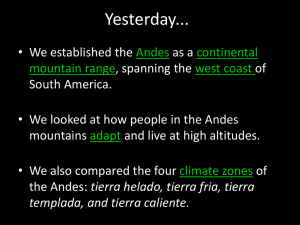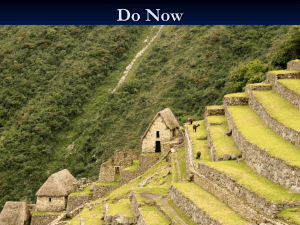UK - Real Science
advertisement
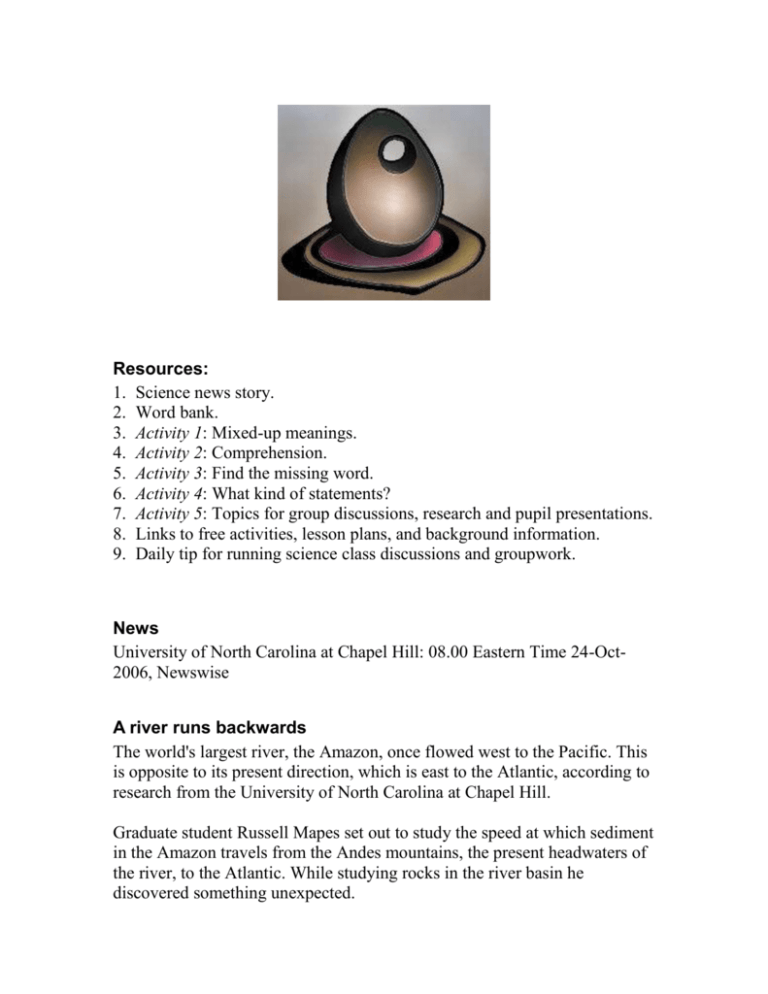
Resources: 1. Science news story. 2. Word bank. 3. Activity 1: Mixed-up meanings. 4. Activity 2: Comprehension. 5. Activity 3: Find the missing word. 6. Activity 4: What kind of statements? 7. Activity 5: Topics for group discussions, research and pupil presentations. 8. Links to free activities, lesson plans, and background information. 9. Daily tip for running science class discussions and groupwork. News University of North Carolina at Chapel Hill: 08.00 Eastern Time 24-Oct2006, Newswise A river runs backwards The world's largest river, the Amazon, once flowed west to the Pacific. This is opposite to its present direction, which is east to the Atlantic, according to research from the University of North Carolina at Chapel Hill. Graduate student Russell Mapes set out to study the speed at which sediment in the Amazon travels from the Andes mountains, the present headwaters of the river, to the Atlantic. While studying rocks in the river basin he discovered something unexpected. This was ancient mineral grains in the central part of South America that could only have come from mountains in the east of the continent. These mountains are now eroded. If the Amazon had always flowed east from the Andes, as it does now, Mapes and his supervisor Drew Coleman would have found much younger mineral grains from the Andes in the sediments. Dr Coleman is a professor of geology at UNC's College of Arts and Sciences. “We didn't see any,” Mapes said. “All along the basin, the ages of the mineral grains all pointed to very specific locations in central and eastern South America. Mapes will present his findings on Wednesday (Oct. 25) at the annual meeting of the Geological Society of America in Philadelphia. Mapes explains that these sediments of eastern origin were washed down from a highland area that formed in the Cretaceous Period. That was between 65 million and 145 million years ago, when the South American and African tectonic plates separated and passed each other. That highland tilted the river's flow westward. This sent sediment as old as 2 billion years toward the centre of the continent. Later, a relatively low ridge, which still exists, rose in the middle of the continent. Called the Purus Arch this runs north and south, dividing the Amazon's flow - eastward toward the Atlantic and westward toward the Andes. Toward the end of the Cretaceous, the Andes started growing, which sent the river back toward the Purus Arch. Eventually, sediment from the mountains, which contained mineral grains younger than 500 million years old, filled in the basin between the mountains and the arch. The river began flowing through the Purus Arch, in its present direction of flow. Previous research had found a reverse flow. But this was only in some parts of the river. Mapes and Coleman traversed about 80% of the Amazon basin. They collected samples of zircon, a mineral found in a wide range of rocks. They dated this to learn the age of the source of the sediment. Their data supported the earlier findings, and indicated a continent-wide shift of the river's flow. It was a surprise, Mapes said. “Just because I didn't have any idea what to expect. I didn't know it would work out so perfectly.” The finding helps show that the surface of the earth is very transient, he said. “Although the Amazon seems permanent and unchanging it has actually gone through three different stages of drainage since the mid-Cretaceous.” This is a short period of time geologically speaking, he added. The research was sponsored in part by the American Chemical Society's Petroleum Research Fund. 500 words Flesch reading ease: 56.9 Flesch-Kincaid Grade level: 9.3 Word bank Pupils will not know some of the words used in the text. Meanings are given below, followed by a table mixed randomly – to provide an exercise in matching words and meanings. By tackling this and the exercises that follow – which are known as directed activities related to texts (DARTs) – pupils can engage with a piece of writing, and learn a great deal from it, even when many of its ideas and words are unfamiliar to them. Word 1 opposite 2 according to 3 sediment 4 headwaters 5 basin 6 ancient 7 mineral 8 continent 9 eroded 10 geology 11 12 13 14 specific location origin Cretaceous Period 15 tectonic plates 16 relatively 17 traversed 18 zircon Meaning the other way; completely different as stated by loose material carried and deposited by water, wind or ice streams from the sources of a river that come together to form the river the land drained by a river and its branches belonging to the distant past; very old a natural crystal, such as diamond or quartz, which has a definite chemical composition one of the world’s main masses of land worn down or away the science of the history of the earth and its life, especially as recorded in the rocks of a particular thing place where something is the point at which something begins time in Earth’s history 143 to 65 million years ago, during which seed-bearing plants first appeared and dinosaurs walked the Earth solid pieces of the Earth’s surface that slowly drift around, floating on the liquid layer beneath, which is called the mantle compared to the average travelled across; passed over zirconium silicate, a hard mineral found in small 19 20 21 22 23 24 source supported indicated transient permanent suspension 25 composition 26 chemical 27 chemistry quantities in a wide range of rocks. (Zircon usually contains radioactive uranium, which makes it very useful for uranium–lead dating of rocks.) where something comes from provided more evidence for was a sign of not lasting long lasting forever or a very long time mixture of small solid particles in liquid or gas, which will settle on standing the parts something is made of produced by chemistry the way substances combine and react with each other Activity 1 Mixed-up meanings Pupils should try to fill the blanks in the final column with the word that matches the meaning. The words needed are listed, randomly mixed, in the first column. This exercise should not be tackled in isolation, but by a reader with access to the story itself: The contexts in which words are used provide powerful clues to their meanings. Word 1 traversed 2 indicated 3 specific 4 sediment 5 composition 6 geology 7 chemical 8 supported 9 opposite 10 eroded Meaning the other way; completely different as stated by loose material carried and deposited by water, wind or ice streams from the sources of a river that come together to form the river the land drained by a river and its branches belonging to the distant past; very old a natural crystal, such as diamond or quartz, which has a definite chemical composition one of the world’s main masses of land worn down or away the science of the history of the earth and its life, especially as recorded in the rocks Word should be 11 mineral 12 zircon 13 suspension 14 headwaters 15 Cretaceous Period 16 according to 17 location 18 basin 19 20 21 22 23 permanent transient ancient origin source 24 continent 25 relatively 26 tectonic plates 27 chemistry of a particular thing place where something is the point at which something begins time in Earth’s history 143 to 65 million years ago, during which seed-bearing plants first appeared and dinosaurs walked the Earth solid pieces of the Earth’s surface that slowly drift around, floating on the liquid layer beneath, which is called the mantle compared to the average travelled across; passed over zirconium silicate, a hard mineral found in small quantities in a wide range of rocks. (Zircon usually contains radioactive uranium, which makes it very useful for uranium–lead dating of rocks.) where something comes from provided more evidence for was a sign of not lasting long lasting forever or a very long time mixture of small solid particles in liquid or gas, which will settle on standing the parts something is made of produced by chemistry the way substances combine and react with each other Activity 2 Comprehension The simple maps at http://www.unc.edu/news/pics/research/MapesAmazonInversion.jpg will help pupils understand the story and answer the following questions: 1. In which mountains does the Amazon river rise nowadays? 2. Are these in the west or east of South America? 3. On the maps the blue areas are the oceans, but their names have been left off. Write Atlantic and Pacific in the correct places. 4. Into which ocean does the Amazon flow nowadays? 5. So today the Amazon flows from ---- to east, which is ---- to right in the maps. 6. Nowadays the Amazon ----- in the Andes mountains and flows right across South America to the -------- Ocean. 7. Sediment is little pieces of rock carried along in a river, sometimes a very long way. What did the scientists set out to study about the sediment in the Amazon? 8. What did they find that surprised them? 9. The scientists looked for sediment that was the same age as the Andes, and found much older sediment. They realised this must have come from a different mountain range. What has happened to that mountain range? 10. What caused this to happen? 11.The scientists’ study of the sediment shows that the Amazon once flowed from mountains in the ---- of South America right across to the ------Ocean. 12.This is exactly -------- to its present direction. 13.Thinking only about the two sets of mountains near the west and east coasts of South America, what made the Amazon stop flowing east to west and start flowing west to east? 14.This simple picture is made a little more complicated by the hilly ridge called the Purus Arch. When it appeared the Amazon split into one river flowing west and the other east (see Figure 2 in the maps). 15.Why could the part flowing west (to the left on the maps) no longer reach the Pacific ocean when the Andes began to form? 16.As the Andes mountains grew, what happened to the river between the Andes and the Purus Arch? 17.Why did this happen? 18. Briefly in your own words state the three stages of flow of the Amazon river since the Cretaceous period, according to this latest research. 19. This was all worked out by studying little grains of rock in the river-bed. The scientists were able to figure out how old the grains were – and from that where their journey had begun. How did they know that very old grains could not have come from the Andes? 20.How do you think the scientists could tell the age of a grain? 21.How likely to be true do you think is this whole picture of the three stages of flow of the Amazon? 22.If you think it might not be true, which part of the scientists’ reasoning could be wrong? 23.Why do you say that? 24.What further questions would you have about all this if you were the scientists? 25.How might you set about trying to answer those questions? Activity 3 Find the missing word Pupils should try to fill in the blanks using clues from the rest of the sentence. When in doubt, the length of each blank indicates the length of the missing word. A complete list of words that belong in the blanks is provided at the end of the passage. A river runs backwards The world's largest river, the Amazon, once ______ west to the Pacific. This is opposite to its _______ direction, which is east to the Atlantic, according to ________ from the University of North Carolina at Chapel Hill. Graduate _______ Russell Mapes set out to study the _____ at which sediment in the Amazon travels from the _____ mountains, the present headwaters of the river, to the Atlantic. While studying rocks in the river _____ he discovered something unexpected. This was ancient mineral grains in ___ central part of South America that could only have ____ from mountains in the east of the continent. These _________ are now eroded. If the Amazon had always flowed east from the Andes, __ it does now, Mapes and his supervisor Drew _______ would have found much younger mineral grains from the Andes in ___ sediments. Dr Coleman is a professor __ geology at UNC's College of Arts and Sciences. “We didn't see ___,” Mapes said. “All along the basin, the ages __ the mineral grains all pointed to very specific locations __ central and eastern South America. Mapes will present his findings __ Wednesday (Oct. 25) at the annual meeting of the __________ Society of America in Philadelphia. Mapes explains that these sediments __ eastern origin were washed down from a highland area ____ formed in the Cretaceous Period. That was between 65 _______ and 145 million years ago, when the South American ___ African tectonic plates separated and passed each other. That ________ tilted the river's flow westward. This sent sediment as ___ as 2 billion years toward the centre of the _________. Later, a relatively low ridge, which still exists, rose in ___ middle of the continent. Called the Purus Arch this ____ north and south, dividing the Amazon's flow - eastward ______ the Atlantic and westward toward the Andes. Toward the end __ the Cretaceous, the Andes started growing, which sent the _____ back toward the Purus Arch. Eventually, sediment from the _________, which contained mineral grains younger than 500 million _____ old, filled in the basin between the mountains and ___ arch. The river began flowing through the Purus Arch, in its present direction of flow. Previous research had found a reverse flow. But this ___ only in some parts of the river. Mapes and _______ traversed about 80% of the Amazon basin. They collected _______ of zircon, a mineral found in a wide range of rocks. They dated this __ learn the age of the source of the sediment. _ Their data supported the earlier findings, and indicated a ______________ shift of the river's flow. It was a surprise, Mapes ____. “Just because I didn't have any idea what __ expect. I didn't know it would work out so _________.” The finding helps show that the surface of the _____ is very transient, he said. “Although the Amazon seems _________ and unchanging it has actually gone through three different ______ of drainage since the midCretaceous.” This is a short ______ of time geologically speaking, he added. These are all the words that belong in the blanks: and, Andes, any, as, basin, Coleman, Coleman, come, continent, continentwide, earth, flowed, Geological, highland, in, million, mountains, mountains, of, of, of, of, old, on, perfectly, period, permanent, present, present, research, river, runs, said, samples, speed, stages, student, that, the, the, the, the, to, to, toward, was, years Answer Key: A river runs backwards The world's largest river, the Amazon, once flowed west to the Pacific. This is opposite to its present direction, which is east to the Atlantic, according to research from the University of North Carolina at Chapel Hill. Graduate student Russell Mapes set out to study the speed at which sediment in the Amazon travels from the Andes mountains, the present headwaters of the river, to the Atlantic. While studying rocks in the river basin he discovered something unexpected. This was ancient mineral grains in the central part of South America that could only have come from mountains in the east of the continent. These mountains are now eroded. If the Amazon had always flowed east from the Andes, as it does now, Mapes and his supervisor Drew Coleman would have found much younger mineral grains from the Andes in the sediments. Dr Coleman is a professor of geology at UNC's College of Arts and Sciences. “We didn't see any,” Mapes said. “All along the basin, the ages of the mineral grains all pointed to very specific locations in central and eastern South America. Mapes will present his findings on Wednesday (Oct. 25) at the annual meeting of the Geological Society of America in Philadelphia. Mapes explains that these sediments of eastern origin were washed down from a highland area that formed in the Cretaceous Period. That was between 65 million and 145 million years ago, when the South American and African tectonic plates separated and passed each other. That highland tilted the river's flow westward. This sent sediment as old as 2 billion years toward the centre of the continent. Later, a relatively low ridge, which still exists, rose in the middle of the continent. Called the Purus Arch this runs north and south, dividing the Amazon's flow - eastward toward the Atlantic and westward toward the Andes. Toward the end of the Cretaceous, the Andes started growing, which sent the river back toward the Purus Arch. Eventually, sediment from the mountains, which contained mineral grains younger than 500 million years old, filled in the basin between the mountains and the arch. The river began flowing through the Purus Arch, in its present direction of flow. Previous research had found a reverse flow. But this was only in some parts of the river. Mapes and Coleman traversed about 80% of the Amazon basin. They collected samples of zircon, a mineral found in a wide range of rocks. They dated this to learn the age of the source of the sediment. Their data supported the earlier findings, and indicated a continent-wide shift of the river's flow. It was a surprise, Mapes said. “Just because I didn't have any idea what to expect. I didn't know it would work out so perfectly.” The finding helps show that the surface of the earth is very transient, he said. “Although the Amazon seems permanent and unchanging it has actually gone through three different stages of drainage since the midCretaceous.” This is a short period of time geologically speaking, he added. Activity 4 What kind of statement? Students should read the news story on page 1 about the latest scientific research, and highlight phrases or sentences according to the following key: Existing knowledge Aims of the research Technology and methods New findings Hypothesis Prediction Evidence IIssssuueess aanndd aapppplliiccaattiioonnss Normally no more than one phrase or sentence should be highlighted in each paragraph, unless the reader decides that a particular paragraph contains several really important ideas. Usually the decision will not be too difficult. But choosing between, say, hypotheses, new findings and predictions can sometimes be tricky. There isn’t always an obviously right or wrong answer, even to the scientists themselves. Pupils should be encouraged not to agonise too long over their choice of statement type, but to be prepared to give reasons for their decisions. Note: A hypothesis is a “tentative explanation that leads to predictions which can be tested by experiment or observation”. Answer Key: (This is an illustrative set of choices. There are many others.) A river runs backwards The world's largest river, the Amazon, once flowed west to the Pacific. This is opposite to its present direction, which is east to the Atlantic, according to research from the University of North Carolina at Chapel Hill. Graduate student Russell Mapes set out to study the speed at which sediment in the Amazon travels from the Andes mountains, the present headwaters of the river, to the Atlantic. While studying rocks in the river basin he discovered something unexpected. This was ancient mineral grains in the central part of South America that could only have come from mountains in the east of the continent. These mountains are now eroded. If the Amazon had always flowed east from the Andes, as it does now, Mapes and his supervisor Drew Coleman would have found much younger mineral grains from the Andes in the sediments. Dr Coleman is a professor of geology at UNC's College of Arts and Sciences. “We didn't see any,” Mapes said. “All along the basin, the ages of the mineral grains all pointed to very specific locations in central and eastern South America. (This is one of those cases where the decision to call a statement a hypothesis or a new finding is not obvious. It depends really on the strength of the evidence available. In this case, given the reliability of the uranium-lead dating method the scientists used, that seems rather strong. Ed) Mapes will present his findings on Wednesday (Oct. 25) at the annual meeting of the Geological Society of America in Philadelphia. Mapes explains that these sediments of eastern origin were washed down from a highland area that formed in the Cretaceous Period. That was between 65 million and 145 million years ago, when the South American and African tectonic plates separated and passed each other. That highland tilted the river's flow westward. This sent sediment as old as 2 billion years toward the centre of the continent. Later, a relatively low ridge, which still exists, rose in the middle of the continent. Called the Purus Arch this runs north and south, dividing the Amazon's flow - eastward toward the Atlantic and westward toward the Andes. Toward the end of the Cretaceous, the Andes started growing, which sent the river back toward the Purus Arch. Eventually, sediment from the mountains, which contained mineral grains younger than 500 million years old, filled in the basin between the mountains and the arch. The river began flowing through the Purus Arch, in its present direction of flow. Previous research had found a reverse flow. But this was only in some parts of the river. Mapes and Coleman traversed about 80% of the Amazon basin. They collected samples of zircon, a mineral found in a wide range of rocks. They dated this to learn the age of the source of the sediment. Their data supported the earlier findings, and indicated a continent-wide shift of the river's flow. It was a surprise, Mapes said. “Just because I didn't have any idea what to expect. I didn't know it would work out so perfectly.” The finding helps show that tthhee ssuurrffaaccee ooff tthhee eeaarrtthh iiss vveerryy ttrraannssiieenntt, he said. “Although the Amazon seems permanent and unchanging it has actually gone through three different stages of drainage since the midCretaceous.” This is a short period of time geologically speaking, he added. Activity 5 Topics for group discussions, research and pupil presentations Science: The idea that mountain ranges are created by forces arising from plate tectonics is one that children – and adults – find hard to understand, if not downright incredible. Pupils could be asked to research and prepare a presentation on this topic. A good place for them to start is http://www.pbs.org/wgbh/nova/everest/earth/birth.html which tackles the birth of the highest mountains on Earth in nice text and animation (Shockwave). Another key scientific idea in this story is deep time or geologic time. Billions of years are so far beyond the bounds of everyday experience that incomprehension or disbelief is almost certain. An appealing classroom activity to help pupils get some feel for the scale of geologic time can be found at http://school.discovery.com/lessonplans/programs/birthofearth The activity is part of a detailed lesson plan on the birth of the Earth from Discovery School. The elaborate picture in this news story – of three stages of flow of the Amazon in the distant past – has been built up by studying little grains of zircon in the river sediment. Some of the more scientifically-minded pupils could research how the age of these zircon grains can be known with such confidence. The method used by Mapes and Coleman is called uranium-lead dating. Encyclopaedia Britannica has a good article on this technique, which explains why it is a particularly reliable dating method. Teachers’ Domain has nice text and video on geological dating using radioactivity: http://www.teachersdomain.org/resources/tdc02/sci/life/evo/radiodating/inde x.html Society: The idea of deep time first appeared in science in the work of James Hutton, a prominent figure in the Scottish Enlightenment. Born in Edinburgh and educated in medicine at the universities of Edinburgh and Paris, Hutton became a successful farmer and industrial chemist, before, late in life, turning his mind to the study of the Earth’s rocks and sediments. This work led to his becoming the father of modern geology. Hutton was the first person to demonstrate that study of the rock particles washed down from rocks and mountains could reveal astonishing details about the Earth’s past. The scientists in this news story are following very much in Hutton’s footprints. Hutton was strongly criticised by religious believers, for whom the story of Earth contained in the Bible was true and unarguable. According to the Genesis account the Earth can only be a few thousand years old. Topic for discussion: If scientific evidence contradicts the stories in the Bible, the Koran or any other ancient texts, what should we believe – and why? Links to activities, lesson plans, background information 1. http://www.teachersdomain.org/resources/ess05/sci/ess/earthsys/rockcycl e/index.html Rock cycle animation, text and discussion questions. From Teachers’ Domain. Free to teachers anywhere, including UK, after simple online registration. 2. http://www.teachersdomain.org/resources/ess05/sci/ess/earthsys/erosion/i ndex.html Erosion and weathering. From Teachers’ Domain. 3. http://csep10.phys.utk.edu/astr161/lect/earth/tectonics.html Background on plate tectonics. Contains an animation of continental drift, and links to information about the geological eras. Note that the Cretaceous is the final period of the Mesozoic. 4. http://www.sci.monash.edu.au/msc/ptr/lessons/docs/earth/tectonics.pdf Lesson for younger kids on continental drift. Not much to it, but this small pdf file has a nice colour diagram showing how convection in the mantle drives continental drift. From Monash University. 5. http://www.earthkam.ucsd.edu/public/students/activities/landformations/ Land features activities. Earth from space, including the Andes. From NASA. 6. http://www.ucmp.berkeley.edu/education/explorations/tours/geotime/ind ex.html Understanding Geologic Time from National Science Foundation. 7. http://www.pbs.org/wgbh/aso/tryit/tectonics Simple plate tectonics activity and explanations for pupils. “This activity lets you manipulate tectonic plates. Pull the plates apart and push them together and watch what happens to the Earth.” 8. http://www.sciencenetlinks.com/lessons.cfm?BenchmarkID=4&DocID= 163 Earth Movers from AAAS: “To explore plate tectonics and to understand how mountains, earthquakes, and volcanoes are related to the movements of plates.” Detailed plans for several interesting lessons aimed at older pupils. Covers plate tectonics, mountain formation, earthquakes. 9. http://www.extremescience.com/AmazonRiver.htm Background on the Amazon and its inhabitants. Link to more links http://cgee.hamline.edu/rivers/Resources/river_profiles/Amazon2.html List of links to Amazon river classroom resources http://members.aol.com/bowermanb/tectonics.html List of links to activities and animations on plate tectonics and continental drift Daily tips for running science class discussions and groupwork Pupils are often critical of small group teaching. The main reason is poor management of the group, especially failure to encourage participation by everyone. A monologue from the teacher is out of place in small group teaching, assuming, as it does, that worthwhile learning only takes place while the teacher is talking. But equally bad is the leaderless or unstructured group, in which students pool their ignorance. Leading and managing good group discussions isn’t as easy as it looks. It takes planning and preparation. There is a tendency to be lulled into a casual approach by the relative informality of the small group. Keeping the benefits of informality, while achieving worthwhile learning, demands interpersonal skills and a focus on learning rather than teaching. Adapted from Craig McInnis, Centre for the Study of Higher Education.



